Class 6 Science Chapter 5 Notes Measurement of Length and Motion
→ In ancient India, people used various units for measuring things. They measured length using units like angula (finger width), which they used for making things and building structures. Even today, craftspeople like carpenters and tailors use angula.
→ Measurement: The process of finding out the size, length, or amount of something using standard units.
→ Distance: The length of the space between two points is called distance. In other words, how far a place/thing is from a point is known as its distance.
→ Units of Length:
a. The metre (m) is the basic unit of length in the metric system.
b. Centimetre (cm) and millimetre (mm) are smaller units used for measuring shorter lengths.
→ The Handspan: The distance across your hand from the tip of your thumb to the tip of your little finger when your fingers are spread out. Here, the handspan used for measurement is an example of unit. When we talk about length, we expressed in two parts: a number that tells us how many handspans long something is, and the unit “handspan” which shows what we are using to measure.
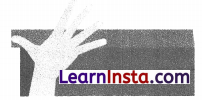
→ SI Units: For the sake of uniformity, scientists from all over the world have accepted a set of standard units of measurement. The system of units now used is known as the International System of Units (SI units). The unit of any physical quantity (e.g. length) which is acceptable to all of the people as basic unit is called standard unit.
For measuring lengths,
- 1 kilometre (km) = 1000 metres (m)
- 1 metre (m) = 100 centimetres (cm)
- 1 centimetre (cm) = 10’millimetres (mm)
- 1 inch (in) = 2.54 centimetres (cm)
![]()
Measurement of Length:
We use various types of measuring devices such as a metre scale, a measuring tape and a 15 cm scale.
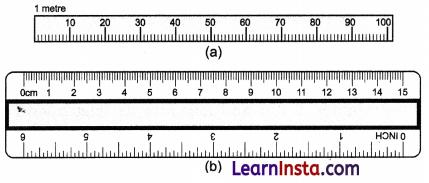
1. Correct way to place a scale:
In figure (a), when you put the ruler right next to the object you are measuring, like a book, you can see exactly how long it is. This gives you the correct measurement.
In figure (b), if you put the ruler far away from the object, you might not measure it accurately. This is because the ruler is not close enough to show the true length of the object.
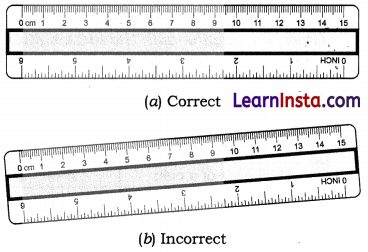
2. Correct placement of eye:
The scale (15 cm) has some thickness. When it is used to measure length of pencil as shown in the figure. We must look vertically down at the mark on the scale coinciding with the tip of the pencil. In case, eye is displaced to the left or right of the vertical, an error in the reading will occur.
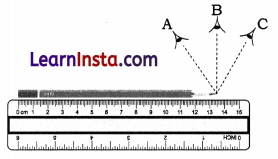
![]()
3. Zero Mark should not be taken as reference point:
When the zero mark is unclear, you can still use it for measuring. Find another clear mark on the ruler, such as 1.0 cm. Then subtract the measurement at this mark -from the measurement at the other end.

Length of a Curved Line:
To measure a curved line, use a flexible tape or string. Lay it along the curve, ensuring it touches each bend. Afterward, straighten it out and measure its length with a ruler or tape for the total curved measurement.
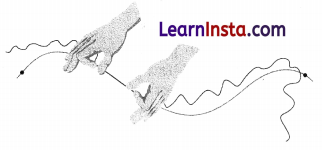
→ Reference Point: When distance is stated with respect to a fixed object or point, then this point is called reference point. It is important in deciding whether an object is at rest or in motion.
→ Motion: An object is said to be in motion if its position changes with respect to the reference point with time.
→ Rest: If an object is not changing its position with respect to the reference point with time, it is said to be at rest.
![]()
Type of motion:
(a) Linear motion: When an object moves in a straight line from one point to another. For example, when a car moves along a straight road.
(b) Circular motion: When an object moves in a circular path around a central point. For example, a merry-go-round at a playground rotates around its centre.
(c) Oscillatory motion! When an object moves back and forth repeatedly around a central position. For example, a swing moving back and forth as someone swings on it.
Note: Both circular and oscillatory motion are periodic in nature.
![]()
→ Centimetre : A centimetre is a unit used for measuring length.
→ Measurement : It is a process of comparing an object with a standard unit of measurement.
→ Classify : Grouping.
→ Circular motion : The motion of a body along a circular path is called circular – motion.
→ Metre : The S.I. unit of measuring length is metre.
→ Explore : Travel through in order to learn about it.
→ Distance : The length of the space between two points (or two places) is called distance.
→ Milliletre : It is one-thousandth of a metre.
→ Identify : Prove.
→ Kilometre : 1000 metres.
→ Motion : An object is said to be in motion when its position changes with time.
→ Investigate : To inquire
→ Length : The extent of separation or the distance between two points in space is called length.
→ Oscillatory motion : When an object moves to and fro about some fixed position, its motion is called oscillatory motion.
![]()
→ Justification : Reasonable.
→ Linear motion : The movement of a body along a straight line is called linear motion.
→ Reference point : When distance is stated with respect to a fixed object or point, then this point is called a reference point.
→ Observe : To see or notice.
→ S.I. unit of length : The S.I. unit of length is metre.
→ The international system of units (S.I. units) has been adopted by countries as standard units of measurement.
→ The S.I. unit of length is metre. Its symbol is m.
→ 1km=1000m, 1m=100 cm, 1cm=10mm
→ When distance is stated with respect to a fixed object to point, this point is called a reference point.
→ When an object not moving, it is said to be at rest.
→ An object is said to be in motion if its position changes with respect to a reference point with time.
→ When an object moves along a straight line, its motion is called linear motion.
→ When an object moves along a circular path, its motion is called circular motion.
→ When an object moves to and fro about any fixed position, its motion is called oscillatory motion.
![]()
→ Motion that repeats itself in a fixed time interval is called periodic motion.
Introduction
In our day-to-day activities, the measurement of physical quantities like mass length, time area, volume, density, speed etc. is done. Division of land, construction of a house, manufacturing of different parts of a machine etc would be impossible without the measurement of the different physical quantities.
Different parts of a machine or a device are manufactured at different places and then assembled in one factory. This has become possible due to the accurate and precise measurements of different parts of the machine.
![]()
How do We Measure?
Many years ago human used different parts of the body to measure length. The hand span, the cubit and the foot were some of the widely used measures of length
- The hand span is the measure of the distance between the tip of the thumb and the tip of the little finger or a fully stretched hand.
- The cubit is the measure of the distance between the elbow and the tip of the middle finger of fully stretched hand.
- A foot is the measure of the distance between the end point of the heal and the big toe.

The length of the food or the hand differs from person to person and therefore cannot be used as reliable units of measurement.
Standard Unit : Several system of units evolved with time in different parts of the world. The system of units now used is known as the ‘International system of Units or S.I. Units’. The S.I. unit of length is metre. Its symbol is ‘m’ A metre scale is shown below in Fig. 2.

It has markings (in cm ) from 0 to 15 . The length of any section between two consecutive big marks, such as between 1,2 or between 5 and 6 , is 1 cm . These sections of 1 cm length are further divided into 10 equal parts. The length of one of these smaller parts is called a millimetre (mm) 1 mm is the smallest value of length that you can measure using this scale. 1 mm is equal to one-length of a centimetre ( 2mm=0.1cm). For measuring larger length; we use a larger unit called kilometre (km).
![]()
1 kilometer is equal to 1000 metres.
1km =1000m
1m=100cm
1cm =10mm
In some scales, we have another scale marking. This scale marking is in inches, where 1 inch =2.54cm}. In earlier days, units, such as inch and foot, were used to measure length.

In some scales, we have another scale marking. This scale marking is in inches, where 1 inch =2.54 \mathrm{~cm}. In earlier days, units, such as inch and foot, were used to measure length.
Correct Way of Measuring Length
For measuring any length, we net an appropriate scale. If we want to measure the length of our pencil, we may use a 15cm scale. Similarly, if the height of a room is to be measured, we may need a metre scale or a measuring tape. We cannot directly measure the girth of a tree or the size of your chest using a metre scale. For such measurements flexible measuring tape, such as a tailor’s tape is suitable.
Proper use of scale:
(i) The scale should be placed along the length to be measured. The scale should be placed to the object to be measured.

(ii) Correct position of the eye: If you are trying to measure the length of a pencil by aligning it with a scale, the position your eye should be directly above the top of the pencil.
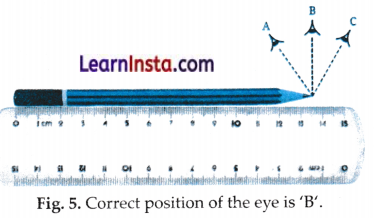
How to measure the length if the ends of the scale are borken?
If the ends of the scale are broken or the zero marking is not clear, it can still be used for measurement.
With such a scale, use any other full mark of the scale, say 1.0 cm . Then subtract the reading of this mark from the reading at the other end. For example, in Fig. 5.6, the reading at one end is 1.0 cm and at the other end, it is 10.4 cm .
Therefore, the length of the object is 10.4cm-1.0cm=9.4cm
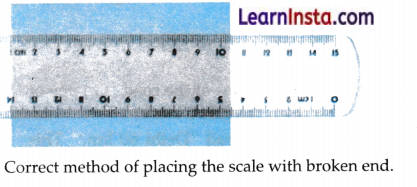
![]()
Units of length, such as kilometre, metre, centimetre and millimetre, begin with a lowercase letter, except at the beginning of a sentence. Their symbols km, m, cm and mm are also written in lower case letters and never followed by ‘s’ for the plural. A full stop is not written after the symbol, except at the end of a sentence. While writing the length, always leave a space between the number and the unit.
Measuring the Length of a Curved line:
In the case of a curved line, measurements can be made with the help of a flexible measuring tape or by using a thread as shown in Fig. 7. The thread can then be straightened and its length can be measured using a metre scale.
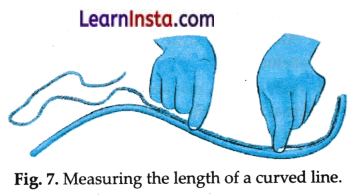
Describing Position :
When distance is stated with respect to a fixed object or point, then this point is called reference points. We can see kilometre strokes on the sides of the road. On one of the kilometre stones, it was written “Delhi 70 km”. Further, on the next kilometer stone read “Delhi 60 km .’ This means we are getting to Delhi.
Moving Things:
There is motion everywhere around us. Animals move from place to place. The earth moves around the sun, aeroplanes fly in the air, rivers flow done from the mountains and so on. When an object changes its position with time, it is said to be in motion. When there is no change in the position of an object, it is said to be at rest. If an object moves very slowly, then it becomes difficult to observe the move immediately. When an object is not moving, it is said to at rest. A house and a tree are not moving, so a house and a tree are said to be at rest. They are not in motion.
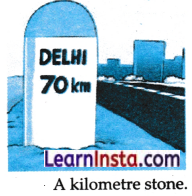
Types of Motion
1. Linear Motion : When an object moves along a straight line path, it is called Linear motion. When a bullet is fired from a gun, the bullet moves in a straight line path. So, the movement of a bullet fired from a gun is an example of rectilinear motion.
2. When an object moves along a circular path, its motion is called circular motion.
![]()
3. When an object moves to and fro about some fixed position, its motion is called oscillatory motion. The movement of the pendulum of a clock is an example of oscillatory motion. The piston of a motor cat, the pressing cylinder of a juice machine at a fruit seller’s shop, the piston of a spray pump, etc. all perform oscillatory motion.
4. Periodic Motion: Motion that repeats itself in a fixed time metal strip. interval is called periodic motion. The hands of a clock have a periodic motion. The motions of the earth are periodic motions; motion of the moon around the earth. Heart beat in a healthy person, motion of the needle (up-down) of a sewing machine, motion of a child on a swing, motion of the branch of a tree moving to and fro are examples periodic motion.